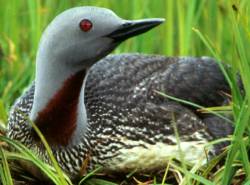Red-throated Diver
|
|
| 'Red-throated Diver | ||||||||||||||
|---|---|---|---|---|---|---|---|---|---|---|---|---|---|---|
 | ||||||||||||||
| Scientific classification | ||||||||||||||
| ||||||||||||||
| Binomial name | ||||||||||||||
| Gavia stellata Pontopiddan, 1763 |
The Red-throated Diver, known in North America as Red-throated Loon (Gavia stellata) is the smallest member of the loon or diver family, typically 55-67 cm (24" to 27") in length with a 91-110 cm wingspan.
The most widely distributed diver, it breeds in northern Eurasia and Arctic Canada. It winters over a much wider range on coasts and on large lakes.
Breeding adults have a grey head, red throat, white underparts and dark mantle. Non-breeding plumage is drabber with the chin, foreneck and much of the face white. Its thin upturned bill is grey or whitish; the upward turn is unique among diver species.
This species, like all divers, is a specialist fish-eater, diving over 25 feet to catch its prey. It is the only species of diver that can take off directly from land. It flies with neck outstretched.
The call is an a yodelling high-pitched wailing.
Other regional names include Cape drake, cape race, cobble, little loon, pegging-owl loon, pepper-shinned loon, rain-goose, scape-grace, sprat loon.da:Rødstrubet lom fr:Plongeon catmarin fy:Lytse Seedûker it:Gavia stellata nl:Roodkeelduiker ja:アビ pl:Nur rdzawoszyi fi:Kaakkuri sv:Smålom
